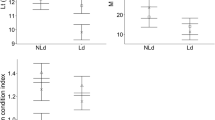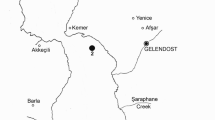Abstract
Asymmetry in the competition abilities between invasive and native consumers can potentially influence the colonization success by invasive species. We tested whether a subsidy of allochthonous prey enhanced an asymmetric competition between invasive bluegill (Lepomis macrochirus) and two native cyprinid fish, that is, stone moroko (Pseudorasbora parva) and tamoroko (Gnathopogon elongatus elongatus). A field experiment was conducted using enclosures wherein the strength of interspecific competition and the presence/absence of allochthonous prey were manipulated. The experiment revealed that allochthonous prey alleviated the limitation of fish growths caused by a severe competition for aquatic prey resources. However, the importance of allochthonous prey differed considerably between invasive bluegill and the two native cyprinids. Individual bluegills grew faster when the allochthonous prey was supplied, whereas no difference in growth was observed in the two cyprinids whether or not allochthonous prey was supplied. Interestingly, the importance of allochthonous prey on the total amount of bluegill growth varied depending on the numerical abundance of native cyprinid competitors, and this importance increased when the native cyprinids were abundant. These findings indicated that allochthonous prey provides an asymmetric growth benefit to invasive bluegills over the two native cyprinids by alleviating asymmetrically the competition strength in a Japanese pond, especially under the conditions of severe interspecific resource competition and a limitation in the utilization of in situ prey resources.



Similar content being viewed by others
References
Azuma M (1992) Ecological release in feeding behaviour: the case of bluegills in Japan. Hydrobiologia 243/244:269–276. doi:10.1007/BF00007042
Baxter CV, Faush KD, Murakami M, Chapman PL (2004) Nonnative stream fish invasion restructures stream and forest webs by interrupting reciprocal prey subsidies. Ecology 85:2656–2663. doi:10.1890/04-138
Beisner BE, Ives AR, Carpenter SR (2003) The effects of an exotic fish invasion on the prey communities of two lakes. J Anim Ecol 72:331–342. doi:10.1046/j.1365-2656.2003.00699.x
Burns JW (1972) Some effects of logging and associated road construction on Northern California streams. Trans Am Fish Soc 101:1–17. doi :10.1577/1548-8659(1972)101<1:SEOLAA>2.0.CO;2
Byers JE (2000) Competition between two estuarine snails: implications for invasions of exotic species. Ecology 81:1225–1239
Clavero M, García-Berthou E (2005) Invasive species are a leading cause of animal extinctions. Trends Ecol Evol 20:110. doi:10.1016/j.tree.2005.01.003
Cooke SJ, Cowx IG (2004) The role of recreational fishing in global fish crises. Bioscience 54:857–859. doi:10.1641/0006-3568(2004)054[0857:TRORFI]2.0.CO;2
Cooke SJ, Cowx IG (2006) Contrasting recreational and commercial fishing: searching for common issues to promote unified conservation of fisheries resources and aquatic environments. Biol Conserv 128:93–108. doi:10.1016/j.biocon.2005.09.019
Crawley MJ (1987) What makes a community invasible? In: Gray AJ, Crawly MJ, Edwards PJ (eds) Colonization, succession and stability. Blackwell Scientific, London, pp 429–453
Cummins KW, Petersen RC, Howard FO, Wuycheck JC, Holt VI (1973) The utilization of leaf litter by stream detritivores. Ecology 54:336–345. doi:10.2307/1934341
Fraser FJ (1969) Population density effects on survival and growth of juvenile coho salmon and steelhead trout in experimental stream-channels. In: Northcote TG (ed) Symposium on salmon and trout in streams. Institute of Fisheries, University of British Columbia, Vancouver, Canada, pp 253–265
Froese R, Pauly D (2007) Fishbase. http://www.fishbase.org, version (11/2007). Cited 10 Jan 2008
Gregory SV, Swanson FJ, McKee WA, Cummins KW (1991) An ecosystem perspective of riparian zones. Bioscience 41:540–551. doi:10.2307/1311607
Holway DA (1999) Competitive mechanisms underlying the displacement of native ants by the invasive Argentine ant. Ecology 80:238–251
Jones EBD III, Helfman GS, Harper JO, Bolstad PV (1999) Effects of riparian forest removal on fish assemblages in Southern Appalachian streams. Conserv Biol 13:1454–1465. doi:10.1046/j.1523-1739.1999.98172.x
Juliano SA (1998) Species introduction and replacement among mosquitoes: interspecific resource competition or apparent competition? Ecology 79:255–268
Kawaguchi Y, Nakano S, Taniguchi Y (2003) Terrestrial invertebrate inputs determine the local abundance of stream fishes in a forested stream. Ecology 84:701–708. doi:10.1890/0012-9658(2003)084[0701:TIIDTL]2.0.CO;2
Kiesecker J, Blaustein AR, Miller CL (2001) Potential mechanisms underlying the displacement of native red-legged frogs by introduced bullfrogs. Ecology 82:1964–1970
Klug JL (2002) Positive and negative effects of allochthonous dissolved organic matter and inorganic nutrients on phytoplankton growth. Can J Fish Aquat Sci 59:85–95. doi:10.1139/f01-194
Merritt RW, Cummins KW (1984) An introduction to the aquatic insects of North America, 2nd edn. Kendal/Hunt, Dubuque
Ministry of the Environment in Japan (2004) Effects of blackbass and bluegill upon the populations of native species and their countermeasures. Japan Wildlife Research Center, Tokyo, Japan
Mooney HA, Hobbs RJ (2000) Invasive species in a changing world. Island Press, Washington
Naiman RJ, Decamps H (1997) The ecology of interfaces: riparian zones. Annu Rev Ecol Syst 28:621–658. doi:10.1146/annurev.ecolsys.28.1.621
Nakamura M (1969) Cyprinid fishes of Japan: studies on the life history of cyprinid fishes of Japan. Research Institute for Natural Resources, Tokyo, Japan
Nakano S, Murakami M (2001) Reciprocal subsidies: dynamic interdependence between terrestrial and aquatic food webs. Proc Natl Acad Sci USA 98:166–170. doi:10.1073/pnas.98.1.166
Nakano S, Miyasaka H, Kuhara N (1999) Terrestrial-aquatic linkages: riparian arthropod inputs alter trophic cascades in a stream food web. Ecology 80:2435–2441
Paetzold A, Bernet JF, Tockner AK (2006) Consumer-specific responses to riverine subsidy pulses in a riparian arthropod assemblage. Freshw Biol 51:1103–1115. doi:10.1111/j.1365-2427.2006.01559.x
Polis GA, Hurd SD (1995) Extraordinarily high spider densities on islands: flow of energy from the marine to terrestrial food webs and the absence of predation. Proc Natl Acad Sci USA 92:4382–4386. doi:10.1073/pnas.92.10.4382
Polis GA, Hurd SD (1996) Linking marine and terrestrial foodwebs: allochthonous input from the ocean supports high secondary productivity on small island and coastal land communities. Am Nat 147:396–423. doi:10.1086/285858
Race MS (1982) Competitive displacement and predation between introduced and native mud snails. Oecologia 54:337–347. doi:10.1007/BF00380002
Shindler DE, Scheuerell MD (2002) Habitat coupling in lake ecosystems. Oikos 98:177–189. doi:10.1034/j.1600-0706.2002.980201.x
Shindler DE, Geib SI, Williams MR (2000) Patterns of fish growth along a residential development gradient in north temperate lakes. Ecosystems (N Y, Print) 3:229–237. doi:10.1007/s100210000022
Taniguchi Y, Nakano S (2000) Condition-specific competition: implication for the altitudinal distribution of stream fishes. Ecology 81:2027–2039
The Ecological Society of Japan (2002) Handbook of alien species in Japan. Chijinshokan, Tokyo
Thompson P, Fox BJ (1993) Asymmetric competition in Australian heathland rodents: a reciprocal removal experiment demonstrating the influence of size-class structure. Oikos 67:264–278. doi:10.2307/3545471
Vinebrooke RD, Leavitt PR (1998) Direct and interactive effects of allochthonous dissolved organic matter, inorganic nutrients, and ultraviolet radiation on an alpine littoral food web. Limnol Oceanogr 43:1065–1081
Wallace JB, Eggert SL, Meyer JL, Webster JR (1999) Effects of resource limitation on a detrial-based ecosystem. Ecol Monogr 69:409–442
Welcomme RL (1992) A history of international introductions of inland aquatic species. ICES J Mar Sci 194:3–14
Werner EE (1986) Species interactions in freshwater fish communities. In: Diamond J, Case TJ (eds) Community ecology. Harper and Row, New York, pp 344–358
Yamanaka H, Kohmatsu Y, Yuma M (2007) Difference in the hypoxia tolerance of the round crucian carp and largemouth bass: implications for physiological refugia in the macrophyte zone. Ichthyol Res 54:308–312. doi:10.1007/s10228-006-0400-0
Yonekura R, Nakai K, Yuma M (2002) Trophic polymorphism in introduced bluegill in Japan. Ecol Res 17:49–57. doi:10.1046/j.1440-1703.2002.00462.x
Yonekura R, Kita M, Yuma M (2004) Species diversity in native fish community in Japan: comparison between non-invaded and invaded ponds by exotic fish. Ichthyol Res 51:176–179. doi:10.1007/s10228-003-0200-8
Yonekura R, Komatsu Y, Yuma M (2007) Difference in the predation impact enhanced by morphological divergence between introduced fish populations. Biol J Linn Soc 91:601–610. doi:10.1111/j.1095-8312.2007.00821.x
Acknowledgements
We express our thanks to I. Kojima, A. Matsumoto, T. Miyano, and T. Koitabashi for their assistance in the construction of the enclosures. Our fieldwork was supported by the efforts of R. Hirasawa, Y. Fukada, T. Takahara, T. Yokokawa, Y. Yamada, T. Hayashi, and M. Yuma. Financial support was provided by the Nippon Life Insurance Foundation.
Author information
Authors and Affiliations
Corresponding author
Rights and permissions
About this article
Cite this article
Yonekura, R., Yamanaka, H., Ushimaru, A. et al. Allochthonous prey subsidies provide an asymmetric growth benefit to invasive bluegills over native cyprinids under the competitive conditions in a pond. Biol Invasions 11, 1347–1355 (2009). https://doi.org/10.1007/s10530-008-9342-y
Received:
Accepted:
Published:
Issue Date:
DOI: https://doi.org/10.1007/s10530-008-9342-y




